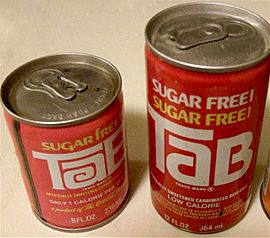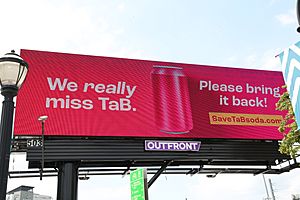Tab (drink) facts for kids
 |
|
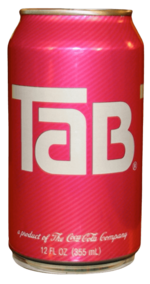
355ml can of Tab
|
|
| Type | Soft drink |
|---|---|
| Manufacturer | The Coca-Cola Company |
| Country of origin | United States |
| Introduced | 1963 |
| Discontinued | December 31, 2020 |
| Color | Caramel |
| Flavor | Diet cola |
| Variants |
Tab Clear
|
| Related products | |
Tab (also written as TaB) was a diet soft drink made by The Coca-Cola Company. It was first introduced in 1963. Tab was Coca-Cola's very first diet drink. It was quite popular in the 1960s and 1970s.
Over the years, many different versions of Tab were made. These included fruit flavors, root beer, and ginger ale. Later, caffeine-free and clear versions were also released.
In the early 1970s, some studies suggested a link between saccharin (Tab's main sweetener) and cancer in rats. Because of this, the United States Congress required warning labels on products with saccharin. However, this rule was later removed. Scientists found that saccharin likely does not cause cancer in humans.
Tab's popularity went down after Coca-Cola launched Diet Coke in 1982. Even so, Tab was still the best-selling diet soda that year. Coca-Cola kept making Tab in the United States, but in much smaller amounts. It had a special group of fans who loved it. In 2006, a Tab-branded energy drink came out, but it was a different kind of drink. Coca-Cola stopped making Tab at the end of 2020.
Contents
The Story of Tab
Tab was created in 1963 by Coca-Cola. They saw how well another sugar-free soda, Diet Rite, was selling. Before Tab, Diet Rite was the only diet soda available. Coca-Cola wanted to make their own. Tab was marketed to people who wanted to "keep tabs" on their weight. This means they wanted to watch their weight.
Coca-Cola used a special computer to help name the drink. Their IBM 1401 computer made a list of over 185,000 four-letter words. They also added names suggested by their own team. They removed words that were hard to say or too much like other brand names. From a final list of about twenty names, "Tabb" was chosen. It was later shortened to "Tab." A designer named Robert Sidney Dickens created the unique "TaB" logo and a new bottle shape.
In the 1970s, Coca-Cola offered six different sugar-free Tab flavors. These included Root Beer, Lemon-Lime, Ginger Ale, Black Cherry, Strawberry, and Orange. In 1983, a version of the original Tab without caffeine was released. This happened at the same time as caffeine-free Coca-Cola and Diet Coke. Tab Clear, a version of Tab without caramel color, came out in 1992. It was sold in the U.S., UK, and Japan. Tab Clear was stopped in 1994.
In 2006, Coca-Cola introduced Tab Energy. This drink shared the Tab name. However, its recipe was completely different from the cola. It was sweetened with sucralose and had a sour, tart flavor.
Saccharin Safety Talk
Tab's recipe changed a few times. At first, it was sweetened with a mix of cyclamate and saccharin. In 1969, the Food and Drug Administration (FDA) banned cyclamate. After that, saccharin became the main sweetener in Tab.
In the early 1970s, studies on lab rats showed a link between large amounts of cyclamate and saccharin and bladder cancer. Because of this, the United States Congress made a rule. All foods with saccharin had to have a warning label. This label said the sweetener had caused cancer in lab animals. Even with this warning, Tab was still very popular. It was the best-selling diet soda in 1982. In 1984, Coca-Cola added Nutrasweet to the Tab recipe. This change made some fans unhappy, and many complained about the taste.
Later, there was no strong proof that saccharin caused cancer in humans. So, in 2000, saccharin was removed from a list of cancer-causing substances. This meant the warning label rule was no longer needed. In 2010, the United States Environmental Protection Agency also removed saccharin from its list of harmful substances.
Where You Could Find Tab
Tab's popularity started to drop in 1982. This was when Diet Coke was introduced. Still, Tab kept a small group of very loyal fans in the United States. In 2008, customers bought about 3 million cases of Tab. In 2011, Coca-Cola said they made about 3 million cases of Tab that year. This was much less than Diet Coke, which sold 885 million cases.
John Sicher, an editor for Beverage Digest, said in 2013: "Tab has small groups of fans around the country. You can see it on shelves in New York and a few other places. It's not a brand you would find in most stores in the U.S. It has a small but loyal following. Coke is right to keep it available."
Tab was also sold in the United States Virgin Islands, the Southern African Customs Union, Norway (called Tab X-Tra), Canada, and Spain.
Tab was available in Australia from the 1960s to the 1980s. It was also sold in the United Kingdom from the late 1970s to the mid-1990s.
In October 2020, Coca-Cola announced they would stop making Tab. This was part of their plan to stop selling brands that were not doing well. This decision happened during the COVID-19 pandemic.
As of June 2021, Tab could still be found at Coca-Cola stores in Atlanta, Orlando, and Las Vegas. It was also in some specific stores in Georgia.
In early 2021, a group of Tab fans started the Save Tab Soda Committee. By July 2022, their petition had over 5,000 names. They also started a billboard campaign in Atlanta. This campaign was aimed at Coca-Cola executives, asking them to bring Tab back.
Different Kinds of Tab
| Name | Year launched |
Notes | Picture | Ref. |
|---|---|---|---|---|
| Tab | 1963 | The original flavor. It was first sweetened with a mix of cyclamate and saccharin. After 1969, only saccharin was used. In 1984, Nutrasweet was added to the recipe. | 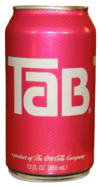 |
|
| Tab Strawberry | 1970s | A diet soda with strawberry flavor. It was sold for a while in the 1970s with other Tab diet drinks. | ||
| Tab Lemon-Lime | 1970s | A diet soda with lemon-lime flavor. It was sold for a while in the 1970s. This was an early version of drinks like Sprite Zero. | ||
| Tab Black Cherry | 1970s | A diet soda with black cherry flavor. It was sold for a while in the 1970s. | ||
| Tab Root Beer | 1970s | A sugar-free root beer. It was sold for a while in the 1970s. | ||
| Tab Ginger Ale | 1970s | A sugar-free ginger ale. It was sold for a while in the 1970s. | ||
| Tab Orange | 1970s | A sugar-free orange soda. It was sold for a while in the 1970s. This was an early version of drinks like Fanta Zero. | ||
| Caffeine Free Tab | 1983 | The original Tab flavor but without caffeine. It was sold in the 1980s and then disappeared. | ||
| Tab Clear | 1992 | A clear diet cola. It was first sold in the U.S. and later in the UK and Japan. It was stopped within a year. | ||
| Tab (Southern African Customs Union variant) | 1990s | In these countries, Tab had a different recipe. It was caffeine-free and had less fizz. You could find it in Botswana, Lesotho, Namibia, South Africa and Eswatini. | 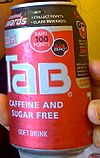 |
|
| Tab X-Tra | 1994 | A version of Tab made in Norway. It was created to compete with Pepsi Max there. It was also sold in Sweden and Finland. It was stopped in Sweden in 2007 and earlier in Finland. After 2007, it was only sold in Norway until 2021. | ||
| Tab Energy | 2006 | An energy drink with the Tab brand name. It had a completely different recipe from the cola. It was also sold in Mexico, New Zealand, and Spain, where it was called Tab Fabulous. | 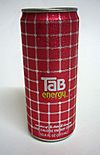 |
See also
 In Spanish: Tab (bebida) para niños
In Spanish: Tab (bebida) para niños


